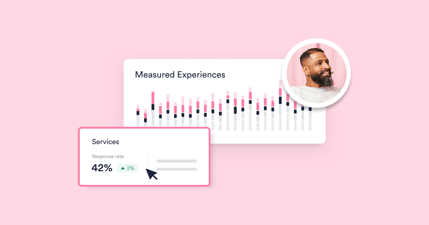A Brief History of IT Experience Management (ITXM)
This blog looks at the history of ITXM, starting with some early employee-experience-related changes.

IT experience management (ITXM) is a hot IT service management (ITSM) trend, but it’s not as new as you might think. When viewed by its alternative names, such as end-user experience management, service experience management, or employee experience management, the latter brings in the human resources (HR) perspective and the history predating HappySignals’ use of the term “ITXM.” This blog looks at the history of ITXM, starting with some early employee-experience-related changes.
The pre-employee-experience focus on employees
Working conditions were harsh in the late 19th and early 20th centuries, and there was minimal concern for employee well-being. Then, labor unions began advocating for better working conditions, fair wages, and reasonable working hours.
In the mid-20th century, the Human Relations Movement highlighted the importance of social factors and employee satisfaction in productivity. Studies found that employees’ attitudes and relationships with supervisors and coworkers significantly impacted their performance. One could see this as the start of employee experience management. HR emerged as a formal organizational function, and the importance of employee morale and job satisfaction began to be recognized.
By the late 20th century, organizations saw employees not just as workers but as valuable assets contributing to competitive advantage. Consequently, companies began investing more in employee training and development, and performance management systems were introduced.
The emergence of employee experience
The early 21st century saw the slow evolution of employee experience management as the concept of “employee experience” started to appear. For many organizations, it traveled in the slipstream of the rapidly growing customer experience movement. Just as customer experience practices focused on delivering exceptional customer experiences (to drive loyalty), organizations started to recognize the importance of creating positive experiences for their employees.
It was aided by the realization that, in what was called “the knowledge economy,” organizations increasingly relied on skilled, knowledge-based workers whose productivity was closely linked to their engagement and job satisfaction. These workers had also become increasingly reliant on technology to do their jobs.
Ushering in the need for ITXM
There are many factors that makeup employee experience. What these factors are and their relative “weighting” differ in the same way that experience management definitions differ across the internet. Jacob Morgan’s “Employee Experience Equation” is one version:
Employee Experience = Culture + Technology + Physical Space
The relative splits of the three equation components are 40% Culture, 30% Technology, and 30% Physical Space. While HR and Facilities are responsible for the first and last of these, the impact of technology sits firmly in the corporate IT organization’s court. Importantly, as with Maslow’s Hierarchy of Needs, it’s unlikely that employee experience will be acceptable if minimum expectations aren’t met across these areas, no matter how great one of them is.
ITXM can be considered to measure how well corporate technology, in the form of services and support, is providing the experiences that help make employees productive. In the same way that employee experience has evolved, IT service delivery and support have evolved, too. It has come a long way since mainframes played a dominant part in corporate technology in the 1970s.
HappySignals has spent the last decade working with customers to define and refine what ITXM is and how it works to improve IT service provider operations, experiences, and outcomes.
The HappySignals ITXM story
We like to think we’ve played a significant role in the history of ITXM and broader experience management and ITSM spaces.
The idea for HappySignals came from a 2014 project to design IT support services using service design methods. Fifty people from a customer organization were interviewed to find out what they really thought about IT support – what they hated and loved about it. The project delivered a service portal designed with and for employees. It also offered the idea that would become HappySignals.
There were more interviews with people in Finnish organizations that discussed two things: service portals and measuring employee experience for service desks. CIOs and service desk directors were measuring customer satisfaction (CSAT), but they didn’t trust the results. Or they didn’t use the feedback.
Almost all the organizations that measured CSAT had an average score of 3.7 (on a scale of 1-5), which had always been the same. The 3.7 was the service level agreement (SLA) target, and there was no motivation to do better. Plus, people thought the service quality was poor despite the SLA target being met. We started to call this the “watermelon effect” – green on the outside but red on the inside.
It was the birth of HappySignals, and after an initial focus on service portal design, we started the product development for our experience measurement product. Since then, we’ve worked with our growing customer base to define and deliver against their needs for human-centric ITXM.
Ten years after that initial project, we co-sponsored the itSMF UK XLA24 event. This showed how much corporate thinking and actions (related to ITXM) have progressed since we started our experience management story and journey in 2014.
ITXM in 2024 and beyond
The first thing to say about ITXM is that the IT industry is still awash with different views and definitions. While experience management, or employee experience management, might be an umbrella term, the technology perspective of experience has multiple names, including digital employee experience management (DEX) and ITXM. While these terms might be used interchangeably with “experience management,” it’s essential to appreciate that they differ. While the DEX approach uses technology to understand how well the IT infrastructure works for employees, the ITXM approach is human-centric – with the opinions of people used to gauge technology experiences. However, both DEX and ITXM solutions provide organizations with experience-focused data and issues.
Many DEX tools are available in the market, each with slightly different capabilities, often driven by the DEX tool vendor’s previous IT management focus. However, a DEX tool’s experience data might be insufficient to understand which discovered issues end-users consider most important. The Forrester Research report “The Future Of IT Experience Monitoring Is Human Centric” echoes this concern. It states organizations can overly focus on experience monitoring technologies without understanding the humans behind the experience. The DEX tools can lack context. This is one of the drivers why customer organizations use the ITXM approach alongside their existing DEX tools. But there’s also another.
The future of ITXM
Corporate IT organizations aren’t the only service providers that can benefit from experience management data and insights – other business functions can, too. The ITXM name might appear prohibitive at first. However, other business functions such as HR and Finance are already employing the ITXM approach to understand the quality of their employee experiences, the business impact, and the improvements needed most. It’s another DEX and ITXM differentiator – unlike the people-centric ITXM approach, DEX tools that monitor the IT infrastructure aren’t designed to fit the needs of these other business functions.
One could argue that employee experience has been evolving since the inception of the Human Relations Movement, making the lineage of ITXM much longer than the time it has been a hot ITSM trend. If you would like to learn more about ITXM, take a look at our ITXM Framework.
Related content

28.03.2024
The Dangers of Relying on DEX Tools Alone
If you look at the various solutions offered in the employee experience market, you’ll notice two main approaches – a ...
Read more >
24.02.2022
Experience Management Acronyms Explained
This article can also be downloaded as a PDF. Some might view experience management as the latest IT service management ...
Read more >
